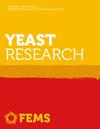Nicotinic acid availability impacts redox cofactor metabolism in Saccharomyces cerevisiae during alcoholic fermentation
IF 2.4
4区 生物学
Q3 BIOTECHNOLOGY & APPLIED MICROBIOLOGY
引用次数: 0
Abstract
Anaerobic alcoholic fermentation, particularly in high-sugar environments, presents metabolic challenges for yeasts. Crabtree-positive yeasts, including Saccharomyces cerevisiae, prefer fermentation even in the presence of oxygen. These yeasts rely on internal NAD+ recycling and extracellular assimilation of its precursor, nicotinic acid (vitamin B3), rather than de novo NAD+ production. Surprisingly, nicotinic acid assimilation is poorly characterised, even in S. cerevisiae. This study elucidated the timing of nicotinic acid uptake during grape juice-like fermentation and its impact on NAD(H) levels, the NAD+/NADH ratio, and metabolites produced. Complete uptake of extracellular nicotinic acid occurred pre-mid-exponential phase, thereafter small amounts of vitamin B3 were exported back into the medium. Suboptimal levels of nicotinic acid were correlated with slower fermentation and reduced biomass, disrupting redox balance and impeding NAD+ regeneration, thereby affecting metabolite production. Metabolic outcomes varied with nicotinic acid concentrations, linking NAD+ availability to fermentation efficiency. A model was proposed encompassing rapid nicotinic acid uptake, accumulation during cell proliferation, and recycling with limited vitamin B3 export. This research enhances the understanding of nicotinic acid uptake dynamics during grape juice-like fermentation. These insights contribute to advancing yeast metabolism research and have profound implications for the enhancement of biotechnological practices and the winemaking industry.烟酸可用性影响酿酒酵母在酒精发酵过程中的氧化还原辅因子代谢
厌氧酒精发酵,尤其是在高糖环境中,给酵母菌的新陈代谢带来了挑战。包括酿酒酵母(Saccharomyces cerevisiae)在内的克拉布特里阳性酵母即使在有氧的情况下也喜欢发酵。这些酵母依靠内部 NAD+ 循环和细胞外同化其前体烟酸(维生素 B3),而不是从头生产 NAD+。令人惊讶的是,即使在麦角菌中,烟酸的同化作用也鲜为人知。本研究阐明了葡萄汁类发酵过程中烟酸吸收的时间及其对 NAD(H)水平、NAD+/NADH 比率和代谢产物产生的影响。细胞外烟酸的完全吸收发生在爆发期中期之前,之后少量维生素 B3 被输出回培养基中。烟酸水平不足与发酵速度减慢和生物量减少有关,会破坏氧化还原平衡,阻碍 NAD+ 的再生,从而影响代谢物的产生。代谢结果随烟酸浓度的变化而变化,从而将 NAD+ 的可用性与发酵效率联系起来。研究提出了一个模型,包括烟酸的快速吸收、细胞增殖过程中的积累以及维生素 B3 的有限输出循环。这项研究加深了人们对葡萄汁类发酵过程中烟酸摄取动态的理解。这些见解有助于推进酵母新陈代谢研究,对提高生物技术实践和酿酒业具有深远影响。
本文章由计算机程序翻译,如有差异,请以英文原文为准。
求助全文
约1分钟内获得全文
求助全文
来源期刊

FEMS yeast research
生物-生物工程与应用微生物
CiteScore
5.70
自引率
6.20%
发文量
54
审稿时长
1 months
期刊介绍:
FEMS Yeast Research offers efficient publication of high-quality original Research Articles, Mini-reviews, Letters to the Editor, Perspectives and Commentaries that express current opinions. The journal will select for publication only those manuscripts deemed to be of major relevance to the field and generally will not consider articles that are largely descriptive without insights on underlying mechanism or biology. Submissions on any yeast species are welcome provided they report results within the scope outlined below and are of significance to the yeast field.
 求助内容:
求助内容: 应助结果提醒方式:
应助结果提醒方式:


